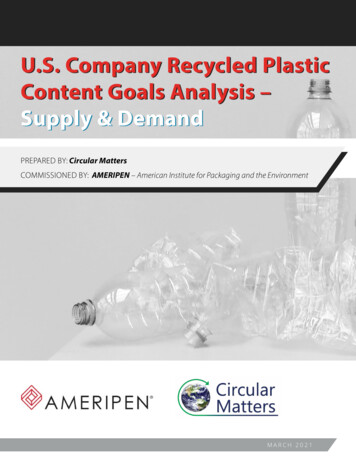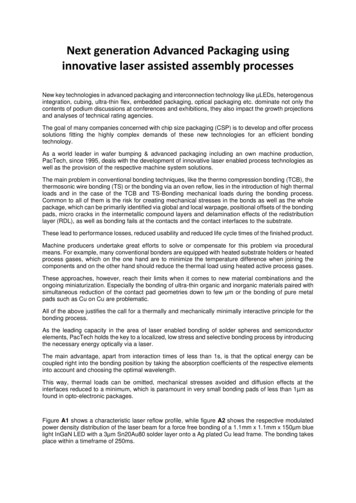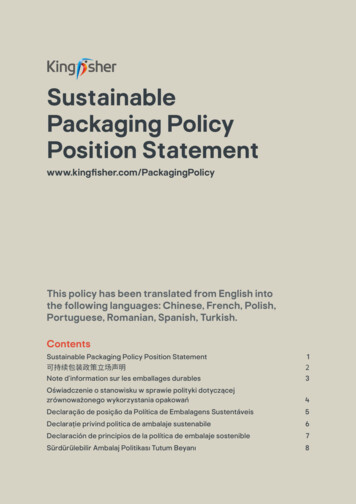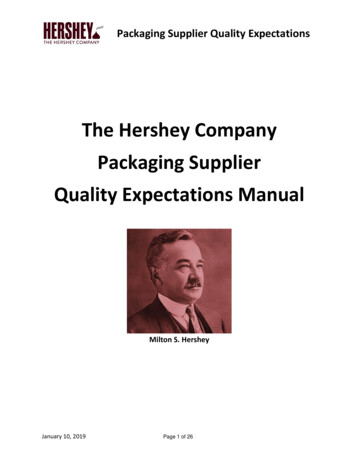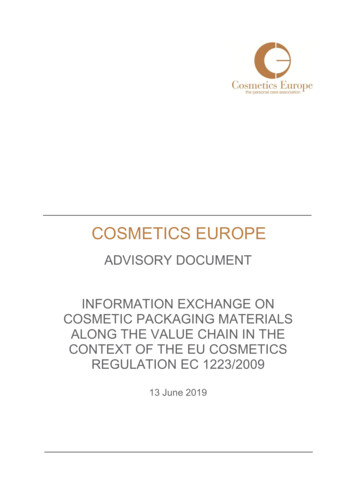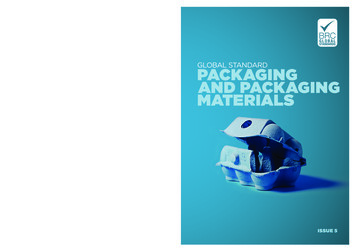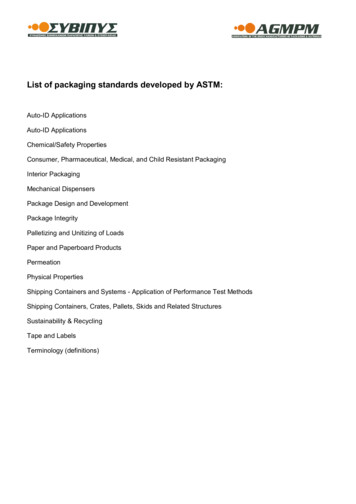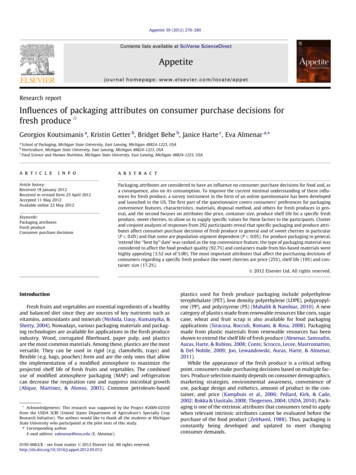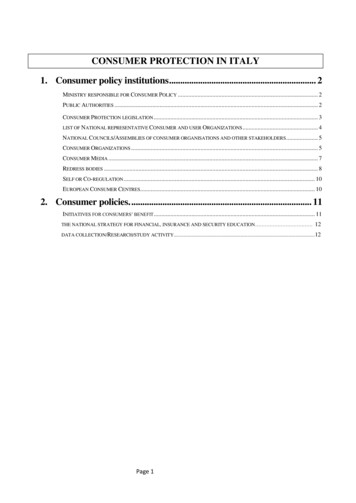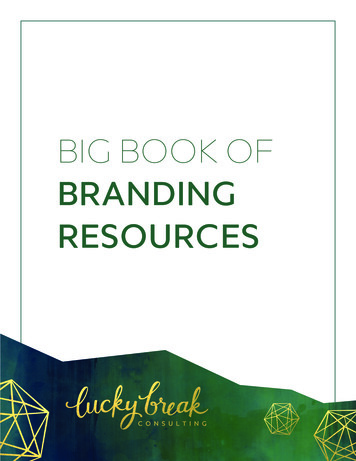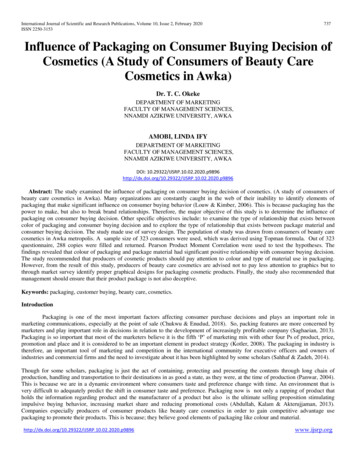
Transcription
International Journal of Scientific and Research Publications, Volume 10, Issue 2, February 2020ISSN 2250-3153737Influence of Packaging on Consumer Buying Decision ofCosmetics (A Study of Consumers of Beauty CareCosmetics in Awka)Dr. T. C. OkekeDEPARTMENT OF MARKETINGFACULTY OF MANAGEMENT SCIENCES,NNAMDI AZIKIWE UNIVERSITY, AWKAAMOBI, LINDA IFYDEPARTMENT OF MARKETINGFACULTY OF MANAGEMENT SCIENCES,NNAMDI AZIKIWE UNIVERSITY, AWKADOI: 0.29322/IJSRP.10.02.2020.p9896Abstract: The study examined the influence of packaging on consumer buying decision of cosmetics. (A study of consumers ofbeauty care cosmetics in Awka). Many organizations are constantly caught in the web of their inability to identify elements ofpackaging that make significant influence on consumer buying behavior (Louw & Kimber, 2006). This is because packaging has thepower to make, but also to break brand relationships. Therefore, the major objective of this study is to determine the influence ofpackaging on consumer buying decision. Other specific objectives include: to examine the type of relationship that exists betweencolor of packaging and consumer buying decision and to explore the type of relationship that exists between package material andconsumer buying decision. The study made use of survey design. The population of study was drawn from consumers of beauty carecosmetics in Awka metropolis. A sample size of 323 consumers were used, which was derived using Topman formula. Out of 323questionnaire, 288 copies were filled and returned. Pearson Product Moment Correlation were used to test the hypotheses. Thefindings revealed that colour of packaging and package material had significant positive relationship with consumer buying decision.The study recommended that producers of cosmetic products should pay attention to colour and type of material use in packaging.However, from the result of this study, producers of beauty care cosmetics are advised not to pay less attention to graphics but tothrough market survey identify proper graphical designs for packaging cosmetic products. Finally, the study also recommended thatmanagement should ensure that their product package is not also deceptive.Keywords: packaging, customer buying, beauty care, cosmetics.IntroductionPackaging is one of the most important factors affecting consumer purchase decisions and plays an important role inmarketing communications, especially at the point of sale (Chukwu & Enudud, 2018). So, packing features are more concerned bymarketers and play important role in decisions in relation to the development of increasingly profitable company (Saghaeian, 2013).Packaging is so important that most of the marketers believe it is the fifth ‘P’ of marketing mix with other four Ps of product, price,promotion and place and it is considered to be an important element in product strategy (Kotler, 2008). The packaging in industry istherefore, an important tool of marketing and competition in the international community for executive officers and owners ofindustries and commercial firms and the need to investigate about it has been highlighted by some scholars (Sahhaf & Zadeh, 2014).Though for some scholars, packaging is just the act of containing, protecting and presenting the contents through long chain ofproduction, handling and transportation to their destinations in as good a state, as they were, at the time of production (Panwar, 2004).This is because we are in a dynamic environment where consumers taste and preference change with time. An environment that isvery difficult to adequately predict the shift in consumer taste and preference. Packaging now is not only a rapping of product thatholds the information regarding product and the manufacturer of a product but also is the ultimate selling proposition stimulatingimpulsive buying behavior, increasing market share and reducing promotional costs (Abdullah, Kalam & Akterujjaman, 2013).Companies especially producers of consumer products like beauty care cosmetics in order to gain competitive advantage usepackaging to promote their products. This is because; they believe good elements of packaging like colour and 20.p9896www.ijsrp.org
International Journal of Scientific and Research Publications, Volume 10, Issue 2, February 2020ISSN 2250-3153738Most previous studies have pointed out to some factors, features and specifications of packaging and their influence on consumers'purchase intentions in different approaches like: understanding of cognitive-perceptual approach on customer purchase intention(Aghai, 2016). Majority of other works on the effect of packaging style, attractive packaging, value and quality of packaging, impulsepurchasing on consumer buying behavior (Chukwu & Enudud, 2018).With previous studies and the lack of understanding of specific elements of packaging like; colour and package materials in this areaprompted this study to evaluate the impact of packaging based on customer purchase intention with some elements of packaging ofcosmetic products. It is necessary for better exploitation of the benefits of packaging industry to the important and influential elementsand criteria identified in packaging and based on consumer opinion to be prioritized in the planning and organization of marketingactivities to be considered. (Sahhaf & Zadeh, 2014).This work therefore, looks at the influence packaging on consumer buying decision of cosmetic products especially beauty carecosmetics. In order to achieve this, some elements of packaging like color, material, graphics and printed information as relevantfactors of packaging have to be looked into to determine their influence on consumer buying decision of cosmetic products.1.2Statement of the ProblemPackaging has a huge role to play in the positioning of products. Today, packages are designed to appeal different occasions,demand to different social groups and even distinguish between different brands. Although, packaging performs an important role inmarketing communications and could be treated as one of the most important factors influencing consumers’ purchase of consumerproducts like cosmetics; the significance of its elements like: colour and material and the level their influence on consumers’ buyingbehavior are still relevant controversial issues for discussion among scholars (Kuvykaite, Dovaliene, & Navickiene, 2009).From extant literature, many organizations are constantly caught in the web of their inability to identify elements of packaging thatmake significant influence on consumer buying behavior (Louw & Kimber, 2006). This is because packaging has the power to make,but also to break brand relationships (Louw & Kimber, 2006). A key example of the latter is a case cited by Hofmeyr and Rice (2007),where a change in pack design contributed towards a drop in a leading beer brand’s market share by more than 20% in the space ofjust one year.In organizations, while designers often emphasize on the “shelf impact” of a package – the visual effect that the package has at thepoint of the purchase when seen in the context of other packages in the category, marketers emphasis more the verbal effect likeproduct information (Silayoi & Speece, 2004).However, we must not fail to not that while common knowledge and mere observation shows that because people cannot process thehuge number of messages they are bombarded with (Jugger, 1999), elements such as colour, and package shape have been suggestedas a means of creating distinctiveness (Gaillard, 2007). Also previous research in branding found shape, colour, logo etc. to be usedacross different communication platforms (Gaillard, Romaniuk, Sharp, 2005; Gaillard, Sharp, Romaniuk, 2006; Romanuik & Sharp,2004).Since, the available empirical literature on this research work do not provide unanimous answer concerning influence of packageelements on consumer buying decision coupled with fact that from the extant literature no or few studies have been conducted todetermine consumer’s perspective on influence of packaging on consumer buying decision in the cosmetic industry in Nigeria andAfrica in general. It is necessary to investigate in detail the influence of both the visual and verbal elements of packaging (color,material, graphics and printed information) on consumer buying decision of cosmetic products. This will help understand andmaximize their different and specific influence on consumer buying decision of cosmetic products.1.2Statement of the ProblemPackaging has a huge role to play in the positioning of products. Today, packages are designed to appeal different occasions,demand to different social groups and even distinguish between different brands. Although, packaging performs an important role inmarketing communications and could be treated as one of the most important factors influencing consumers’ purchase of consumerproducts like cosmetics; the significance of its elements like: color, material, graphics and product information and the level theirinfluence on consumers’ buying behavior are still relevant controversial issues for discussion among scholars (Kuvykaite, Dovaliene,& Navickiene, 2009).From extant literature, many organizations are constantly caught in the web of their inability to identify elements of packaging thatmake significant influence on consumer buying behavior (Louw & Kimber, 2006). This is because packaging has the power to 9896www.ijsrp.org
International Journal of Scientific and Research Publications, Volume 10, Issue 2, February 2020ISSN 2250-3153739but also to break brand relationships (Louw & Kimber, 2006). A key example of the latter is a case cited by Hofmeyr and Rice (2007),where a change in pack design contributed towards a drop in a leading beer brand’s market share by more than 20% in the space ofjust one year.Currently, two categories of packaging elements have been established in marketing literature that affect a consumer's purchasedecision: visual elements and verbal (also sometimes called informational) elements (Silayoi & Speece, 2004).Visual elements consist of color, form, size, material and graphics while verbal elements describe for example brand, producer andcountry-of-origin (Kuvykaite, Dovaliene, & Navickiene, 2009). Visual elements provide information that affects the consumer’semotions whereas verbal elements send out information that has an effect on the consumer's cognitive orientation (Silayoi & Speece,2004).In organizations, while designers often emphasize on the “shelf impact” of a package – the visual effect that the package has at thepoint of the purchase when seen in the context of other packages in the category, marketers emphasis more the verbal effect likeproduct information (Silayoi & Speece, 2004).However, prior to this research, few studies have been conducted in regard to packaging design and purchase decision. Comparing theimpact of visual and verbal elements of package on consumers’ purchase decisions it could be stated that verbal elements are moreimportant than visual ones. This is because packaging has several tasks including cutting through the muddle to get consumers tonotice/see the product; communicating marketing information; stimulating brand impressions; and providing various brand cues(Louw & Kimber, 2006). On the contrary, according to Kuvykaite’s (2009) research on the impact of package elements on consumerpurchase decision economics and management concluded that visual elements are more important. According to him, material is themost important visual elements for purchasing; colour and graphics were regarded as unimportant elements of package. However, wemust not fail to not that while common knowledge and mere observation shows that because people cannot process the huge numberof messages they are bombarded with (Jugger, 1999), elements such as colour, and package shape have been suggested as a means ofcreating distinctiveness (Gaillard, 2007). Also previous research in branding found shape, colour, logo etc. to be used across differentcommunication platforms (Gaillard, Romaniuk, Sharp, 2005; Gaillard, Sharp, Romaniuk, 2006; Romanuik & Sharp, 2004).It is therefore obvious from the extant literature that there are discrepancies not only in the opinions and observations of designers andmarketers of some organizations but also in the findings of scholars in this area. Therefore, to achieve the marketing objective for thebrand and satisfy the desires of consumer, the aesthetic and functional components of packaging must be chosen correctly” (Keller,2009). Kapferer (1997) asserts that the aesthetic considerations relate to a package’s size and shape, material, colour, text andgraphics, while the functional connotes product information. The impact of package and its elements on consumers’ purchasedecisions can be revealed by analyzing the importance of its separate elements for the consumer’s choice.Since, the available empirical literature on this research work do not provide unanimous answer concerning influence of packageelements on consumer buying decision coupled with fact that from the extant literature no or few studies have been conducted todetermine consumer’s perspective on influence of packaging on consumer buying decision in the cosmetic industry in Nigeria andAfrica in general. It is necessary to investigate in detail the influence of both the visual and verbal elements of packaging (color,material, graphics and printed information) on consumer buying decision of cosmetic products. This will help understand andmaximize their different and specific influence on consumer buying decision of cosmetic products.1.3Objectives of the StudyThe major objective of this study is to determine the influence of packaging on consumer buying decision.Other specific objectives include:1.To examine the type of relationship that exists between color of packaging and consumer buying decision.2.To explore the type of relationship that exists between package material and consumer buying decision.1.4Research Questions1.What type of relationship exists between color of packaging and consumer buying decision?2.What is the relationship between package material and consumer buying decision?1.5Research HypothesesThe following hypotheses have been formulated in line with the research objectives:H 1:There is a significant relationship between color of packaging and consumer buying decision.H 2:There is a significant relationship between package material and consumer buying 20.p9896www.ijsrp.org
International Journal of Scientific and Research Publications, Volume 10, Issue 2, February 2020ISSN 2250-31537402.1 Functions of Good PackagingPackaging performs many functions according to Onuoha and Egbuta (2010) packaging performs two basic functions which includeprotective function and promotional function. While according to Anyanwu (2000) the importance of packaging can be consideredfrom three functional perspective of;Protective functionPromotional functionPerceptual functionNwaizugbo and Onyeka (2013) gave their function as protecting the product, promotion function, utility function, productdifferentiation and product development function.Basically, the functions of any package will be to protect the product the in the container. Design and promotional considerations areincreasingly coming out in producing packages. In few cases there will be a conflict between what the manufacturers think theproduct ought to offer. In looking at the functions of packaging, it is profitable to consider the distributors, consumer and legalrequirement for a package.i. Distributor RequirementThe legal length of the distribution channel should be taken into consideration when designing packages. The amount of handling thecontainer will receive and variations in climate conditions, which may be encountered between the point of manufacturing and sale,should be considered, attention should also be considered when designing package sales per square root or per linear foot of shelf aremeasures often used to measures retail productivity and retailers are likely to avoid packs that will occupy a disproportionate amountof space in relation their value.ii. Consumer RequirementConsumer want product but have little direct interest in the Packaging in the packaging of these products. Consumers are however,receptive to technical and aesthetic improvement in pack design, it is almost impossible to differentiate many competing productson the basis of objects criteria and their cases packaging and promotion constitute the sole distinguishing features upon which theproducts success or failure depends. Many products are not consumed immediately after purchase or after the package is opened.They are often used over varying periods of time. To prevent spoilage such product must be packed in reasonable packs.iii. Legal Requirement1.2.3.The production and design of packaging is influenced the increasing amount of information, which by law must appear on it. Theselegal requirements are not being taken seriously Nigeria manufactures. The increasing amount of information, which by law mustappear on it. These legal requirements are not being seriously by Nigeria manufactures. The Nigerian standard organization, which issupposed to ensure compliance, does not appear to do a very good job. Example is given below about the nature of productsinformation required. Consumer products should be marked with Name and address of the manufacturer Description of product Any Relevant Expiring Date Warning of Caution Necessary and Required References to Particulars.The rights to package design are also legal legal aspects of packaging. Design registration can be very valuable, especially in thearea of wine, spirit, toiletries and cosmetics packaging. Means of securing the legal right over a product include the following.a) Patent right: for a new invention of application.b) Copy right: provided the existence and ownership can be proved. This is a powerful weapon against imitations.c) Trademarks: may assist in distinguishing packaging from competitors. To secure ownership of these legal rights, oneshould.Identify a designer: that means there is need to know who made who made the design, are there an employee or contracted labour?One person or several?Ensure that the rights have been assigned to him.There should be a standard clause in contracts of employment of copyrights.Format assignment documents for employees and contracted workers may be advisable.Keep the original drawing: A file should be kept with the history of development of the packaging.2.1.2 Packaging Elements4. According to Nilson and Ostrom (2005), the product packaging design includes the brand name, colour, topography andimages, all which influence how quickly and easily a product catches the eye. Kotler (2004), distinguished six elements thatmust be appraised when taking packaging decisions; Size, Form, Colour Material, Text and Brand. Smith and Taylor .p9896www.ijsrp.org
International Journal of Scientific and Research Publications, Volume 10, Issue 2, February 2020ISSN 2250-31535.6.7.8.9.10.11.12.13.14.15.16.741noted that there are six variables that must be taken into consideration by producers when creating packaging and they include:Form, Size, Colour Graphics, Material and Flavour.According to Silyoi and Speece (2007), there are two categories of elements: Visual elements and Informational elements.Visual elements include: graphic, colour, shape and size while informational elements are information provided andtechnology. According to the, visual elements are related with affective aspect of consumer decision making process, whileinformational elements are related with cognitive one. The visual elements of packaging have a stronger influence on thepurchasing when consumers have low involvement in the purchase, in other words, when the product is of low risk and lessexpensive. They also have a strong impact on impulse purchases (Nilson & Ostrom, 2005).In summary, there are two main blocks of packaging from the analysis of the literature and they include: Visual (graphic,colour, brand name, size, shape, form, and materials) and Verbal (printed information, producer, country of origin and brandname).ColourColour plays an important role in a potential customer’s decision making process, certain colours set different moods and canhelp to draw attention (Deliya & Parmar, 2012). According to Harper and Miller Burns (2012), aligning fragrance and color isone of the most important tools a brand can wield in the perfume industry. It is important because product labels, packagingand colors have to be congruent with the odor of the product (Milotic, 2001). Same applies to food packaging, where thepackage cannot look better than the food tastes (Meyers and Gerstman, 2005). Colors and smells can nonetheless be learned ifthe color and odor are dissimilar (Milotic, 2001), though this is difficult to achieve because people have already strongassociations with colors (Wu et al, 2009).Colors should not be looked upon as mere decorative means when incorporated in package design because they bring withthem strong symbolic significance. Consumers have a direct sense for a product's colors as it impacts on their visual andpsychological feelings (Wu et al, 2009).The first color function is that of catching the attention of consumers, especially at the point of purchase, where it has beenproven that particularly vibrant colors, such as red and yellow attract attention. According to Wu et al (2009), red makes peopleexcited while blue calms people, and this is because each color has its own meaning. Warm colors suggests fire and sun (bothvery progressive) and cool colors imply air and water (giving a tranquil feeling). The use of colors plays a big part in creatingan aesthetic experience as they can reflect different characteristics, moods and temperaments (Wu et al, 2009). The moodsassociated with colors are advantageous if a brand needs a fresh beginning as a new package whose coloris very different to abrand's original package color, will attract the customer's attention. This makes the product more probable for purchase than apackage whose color is moderately different (Garber, Burke and Jones, 2000).SizeThe effect of packaging size has a strong influence on the purchasing when the quality of the product is hard to determine(Silayoi & Speece, 2007). However, packaging size depends on product features and target market (Smith, 2004). According toAgariya (2002) different packaging size is a way to extend a product into new markets. The two visual elements shape and sizehave been written under one title here because they are particularly intertwined with each other. a manufacturer of paper cups isfacing competition from a company that makes larger cups. The manufacturer wants to design a larger paper cup thatmaximizes perceived volume for the same amount of raw material. What shape of cups should it make?" (Raghubir andKrishna, 1999). There is a common saying among designers, that form follows function, (Adhesives & Sealants Industry, 2011)though technological changes in materials such as plastics has lead to new approaches in packaging where various designparadigms are incorporated into the package shape. Though there does not seem to exist conventional understanding regardingpackage shapes, many shapes are today part of the brand image, one of the most famous examples being the Coca-Cola bottle.It is also important for producers to consider different dimensions of the package's shape when introducing new products(Raghubir and Krishna, 1999).Designers need to appreciate how visual elements communicate and create abstractperceptions in the consumer's mind. So within the design process, designers should convey various feelings according to theshapes of different objects. For instance, square shapes give a sense of stability while circular shapes are perceived more ascomplete or perfect (Wu et al, 2009). Another thing to consider is that larger portions are often associated with higher socialstatus and people may choose larger portions when they feel powerless and want to affirm themselves (Chandon, 2012).With other things the same, packages that appear larger will be more likely to be purchased, that is if the consumer does notread the information provided on the package concerning volume. Both consumer perceptions and volume have manyconnotations for package shape decisions (Raghubir and Krishna, 1999). Especially, the height of a container is considered animportant dimension that consumers commonly use as guidance to make volume judgment.Consumers cluster most existing standard packages into four shape categories, these are cylinders, kegs, bottles, and spatulates,and each of these shape-types present characteristic effects on volume appearance, according to Garber, Hyatt and Boya(2009). In their study, the authors found that tall bodies give a larger overall package volume appearance than short bodies do,and geometrically complex forms are perceived as smaller than simple forms. Also, for packages that have compound complexforms that are composed of noticeable joining of two or more parts (including necks, shoulders, bodies, and feet), consumerstend to look at the body of the package to determine the .p9896www.ijsrp.org
International Journal of Scientific and Research Publications, Volume 10, Issue 2, February 2020ISSN 2250-315374217. It is also important to note that cultural differences do effect preferences in package design elements (Adhesives & SealantsIndustry, 2011),and so does practical limits on how large or how miniature a package can be (Garber Jr., Hyatt and Boya,2009).18. Material19. When choosing between multiple products, particularly when the consumer is more involved in the process, he will oftenchoose the higher priced item because the higher price implies higher quality (Deliya & Pamar, 2012). According to them, thesame is true of packaging material; higher quality packaging and labels will influence the consumer to purchase more oftenthan low quality packaging. Krasovec (2006) in their study divided materials used for packing into several types: paperboard,plastics, glass and metal. Material semantics of package design describes the communication of materials, texture and the fabricinformation of products (Wu et al, 2009), and as the packaging market is a highly competitive place, the actual packaging hasbecome as significant to success as the product it is wrapped around (Daily Foods, 2001).20. According to Daily Foods (2001) developing and selecting the "right" container that successfully markets a product, especiallyfoods, requires an understanding of packaging materials. Packaging professionals need to understand the advantages anddisadvantages of particular materials and how they can be used to differentiate the product. The most used materials inpackaging are today classified into plastic, paper, metal and glass (Hong & Suhua, 2011). Plastic started to be used forpackaging in the beginning of the 20th century and has become the most economically popular packaging material. Paperpacking is also a very fashionable choice because of its formability and low cost. Aesthetically it is also a great marketingchoice as beautiful pictograms can be directly printed onto the package.21. Metal packaging materials are known for being especially useful for protecting food during long periods of time, especially atwar, during the 19th century. Today metal is still going strong due to its protecting character. But what has really made metal afavorite among packaging professionals is the ability to shape it into many different forms, and designers can get very creativewith the shape and size of their containers with the use of metal (Hong & Suhua, 2011).22. Finally, glass is another favorite among producers as it also can form into various shapes. It is hard, transparent, heat-resistantand can be easily cleaned. It is primarily used for oil, alcoholic drinks, beverages and cosmetics. What might be considered as anegative aspect of glass as a packaging material is that it is fragile, relatively heavy and the cost of transporting and storing thematerial is rather high (Hong and Suhua, 2011).2.1. 3 Problems of Packaging;Today’s consumers is faced with so many problems because purchasing is becoming impersonal more so, products themselves arebecoming more complex, because products are sometimes wrapped in plastic container that make it difficult for the consumer to evenknown when faced with conflicting and confusing advertisement. Most of the packaging in Nigeria are not adequately compelled to perform according to set standards. Mostly the packagingmaterial often used mostly in the information voriting on packaging are so inadequate that the after effect of such a product,the direction of use, the weight etc. are no longer required as far as the manufacture is consigned. Another major problem confronting packaging in Nigeria is the issue of monopoly or near monopoly or mar monopoly.Most of manufacturers of packaging material are few in the country. consumers do not know their basic right regarding packaging most of them are grant, under the sale of Good Act (1979, forinstance, the seller gives the consumer implicit under taking that the goods are of merchantable quality that is, they are notbroken or damaged and that they will work properly because the consumers are ulitertes, any type of product can be sold tothem without them protesting against it.2.1.4 Strategies of Consumer Buying ProcessThe customer buying process also called a buying decision describes the
cosmetics. In order to achieve this, some elements of packaging like color, material, graphics and printed information as relevant factors of packaging have to be looked into to determine their influence on consumer buying decision of cosmetic products. 1.2 Statement of the Problem Packaging has a huge role to play in the positioning of products.
